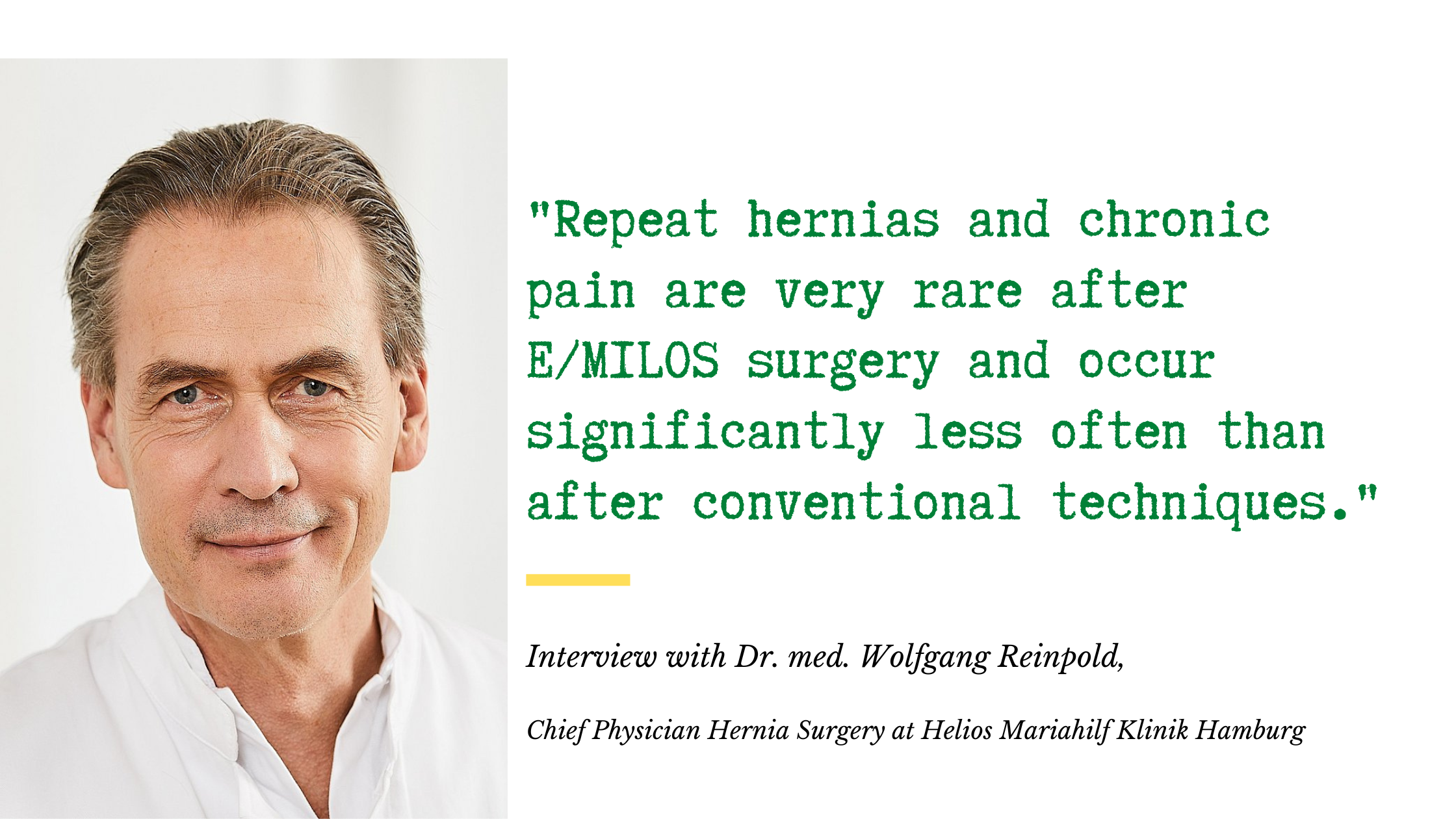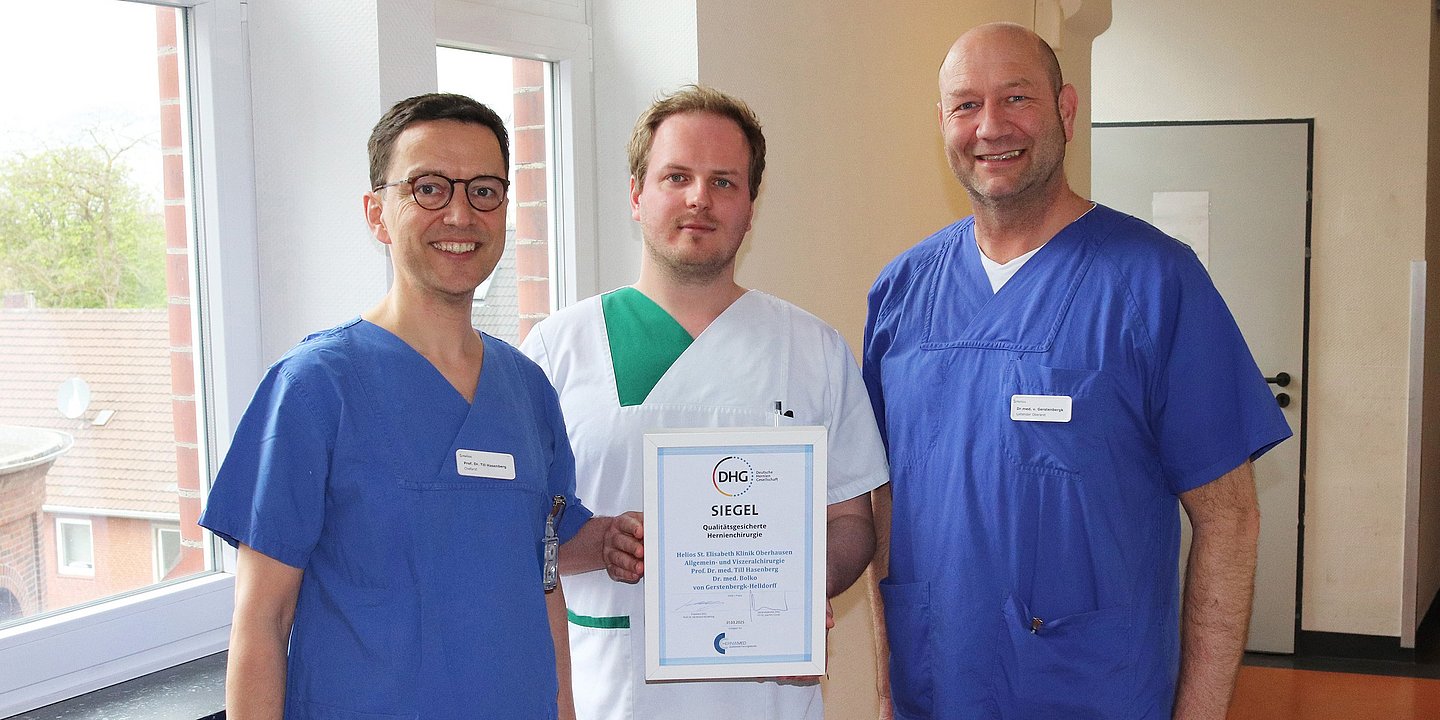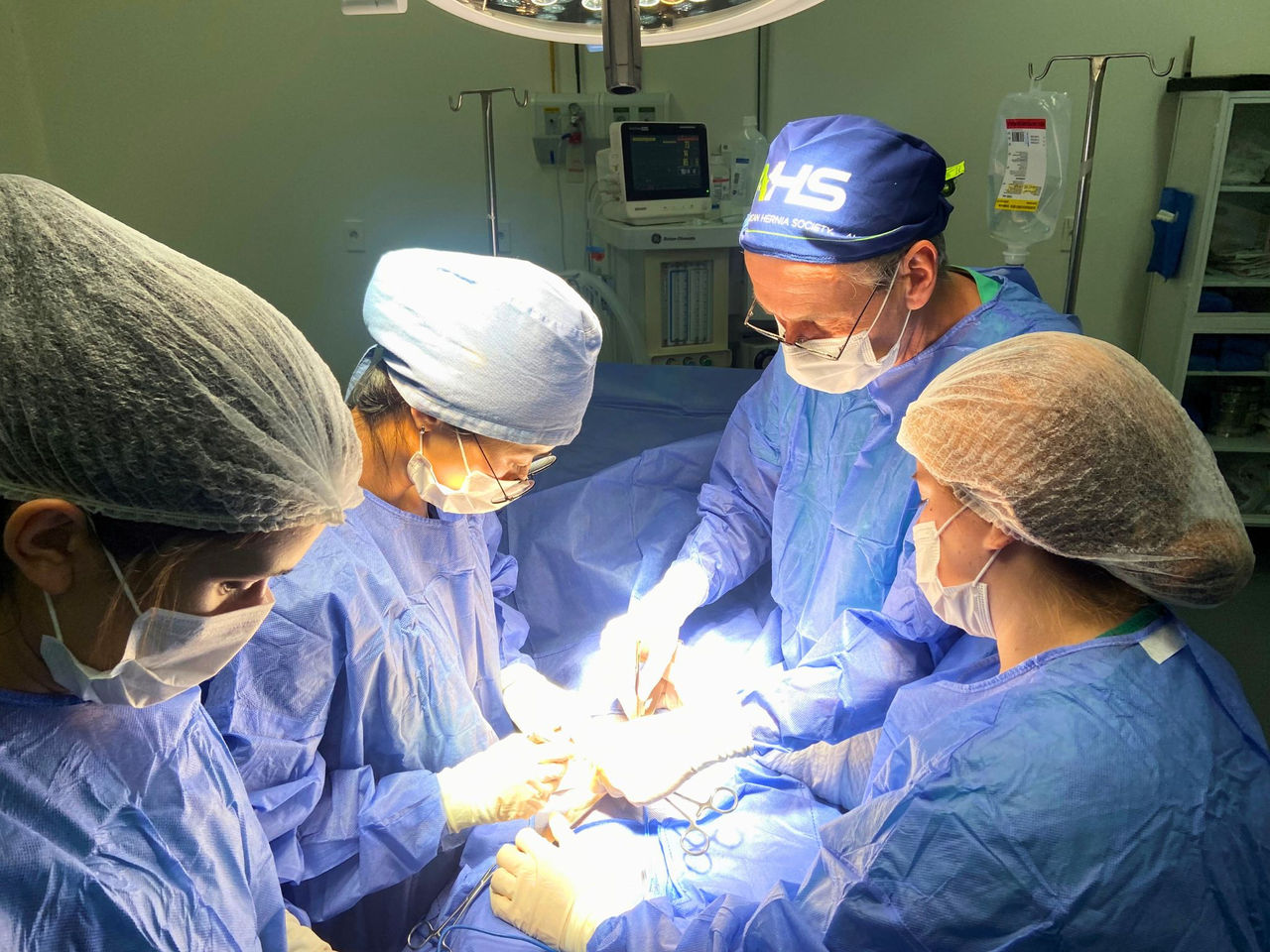
Hernia and abdominal wall surgery: An interview with Dr. med. Wolfgang Reinpold
"Surgical competence is extremely important. Above all, however, is humanity!".
Dr. med. Wolfgang Reinpold, is one of the international opinion leaders and top specialists in hernia and abdominal wall surgery. Since 2020, he has been one of the top five European specialists in this field. The focus of his scientific work is the development of minimally invasive techniques to prevent complications, especially recurrent hernias and postoperative pain.
-
You specialize in hernia and abdominal wall surgery. Would you tell us about your career? How long have you been working in the field of hernia surgery?
Dr. med. Reinpold: We are a leading international center for inguinal and abdominal wall hernias and diaphragmatic hernias. We have been working with Helios since 01.04.2021, for almost two years now, within the framework of a cooperation. I am employed at Helios Mariahilf Hospital as the head physician of abdominal wall and hernia surgery. Before that, I was the head of the surgical department at the Groß-Sand Hospital in Hamburg for almost 20 years. Then I decided to become self-employed and founded the Hamburg Hernia Center together with my partner, Professor Dr. Henning Niebuhr. We currently perform a total of approximately 3,000 hernia operations per year with four surgeons. Another colleague will join us on April 1, 2023, making us the largest hernia center in Europe. I enjoy this work very much and I feel very comfortable in what I do.
Hernia surgery is a big part of general and visceral surgery and in a way deals with the envelope or the wall of the abdomen. The bottom line is to take care of holes that are caused by a weakness in the connective tissue, which is mainly genetic. Actually, hernia surgery is part of the training and also the daily bread of every general surgeon, but due to the development of new techniques in recent years (including minimally invasive surgery), hernia and abdominal wall surgery has become an independent specialty of surgery worldwide. There has been a specialization in hernia and abdominal wall surgery at the European level for almost two years. I am one of the first five specialists to receive this title (F.E.B.S/AWS, editor's note). It is now also accepted worldwide that it is a specialty in its own right, since this work accounts for almost 20 percent of the workload of general and visceral surgery.
I started working in surgery in Reinbek in 1990, as an AIP (doctor in internship, editor's note) under Prof. Albrecht Eggert, MD. At that time, he was already very interested in hernia surgery and very early had the idea to specialize in hernia surgery. In the early/mid 1990s, he founded the first hernia center in Germany at Reinbek Hospital. At that time, Prof. Eggert gave me the task of establishing and managing the hernia center. Prof. Eggert, from whom I learned a great deal, sent me to various international hospitals with a focus on hernia surgery when I was still a young resident. Among others also to the renowned Lichtenstein Hernia Institute in the USA, from where this highly specialized field originates. Already in the 1990s I was in the USA several times and learned the original Lichtenstein technique there. As a result, I had a close relationship with the top hernia specialists worldwide at an early stage.
On the other hand, I am a very broad-based surgeon. I am a general, trauma and abdominal surgeon. Abdominal wall and hernia surgery has always been my specialty and has fascinated me because it is a really challenging, clean and aesthetic surgery that is quite complex anatomically. You need a great skill for it, a good surgical hand and a good spatial awareness to be able to successfully perform this type of surgery. I am one of the surgeons who started my training when minimally invasive laparoscopic surgery was introduced. In the early 1990s, it started with laparoscopically operated gallbladder procedures. It was always clear to me: minimally invasive surgery, i.e. surgery with small incisions, is what should always be preferred, if it is possible.
In addition, at the end of the 1980s/beginning of the 1990s, another development became apparent and began to take hold: That plastic implants were essential in adult inguinal hernia, abdominal wall and incisional hernia surgery. If the gaps were only sutured, then in many cases this would not hold in the long term due to the genetically underlying weakness of the connective tissue. Often this would lead to repeat fractures or treatment failure. The second maxim or guiding principle, which I therefore understood very quickly, is: hernia surgery should be as minimally invasive as possible, as laparoscopic as possible, and plastic meshes are indispensable!
In the early 1990s, the first laparoscopic inguinal hernia techniques were developed, including the so-called TAPP technique (Transabdominal Preperitoneal Patch Technique, editor's note). This procedure is still the procedure of choice today. We perform these operations on groins whenever possible. The advantage is that you can operate on the hernia with three tiny incisions around the umbilicus and therefore very little access trauma. The plastic meshes are placed outside the abdominal cavity in the TAPP technique.
The problem is that this concept of extraperitoneal care (insertion outside the abdominal cavity, editor's note) works very well in the groin area, but minimally invasive insertion of the plastic meshes above the groin, for all other hernias, is extremely difficult. That is why a laparoscopy technique was developed for abdominal wall and incisional hernias, in which the plastic implants were inserted into the abdominal cavity and had to be attached to the abdominal wall or the pain-sensitive peritoneum from the inside. I have always rejected this technique. As an abdominal surgeon, it has always been clear to me that whenever possible, one should avoid inserting foreign material into the abdominal cavity because it is a risk factor for the bowel and can lead to severe, painful adhesions.
The industry has developed coated meshes that were supposed to be safe. These nets have never been properly tested in large clinical trials in humans. There have been small series of animal studies comparing conventional nets with coated ones, but this has never been very conclusive. My goal was to develop a technique to insert the plastic meshes miminalinvasively outside the abdominal cavity.
In 2003, at the beginning of my time as chief physician in Groß-Sand, I also founded a hernia center there and immediately began to develop new techniques for abdominal wall surgery. We have thus triggered a new trend worldwide: Away from abdominal wall and incisional hernia operations with mesh in the abdomen, towards new minimally invasive techniques with plastic mesh insertion in sublay position (between the peritoneum and the supporting abdominal wall). The abdominal wall and incisional hernia techniques we have developed, MILOS, EMILOS and laparoscopic transperitoneal sublay technique (TARUP), do not require painful mesh fixation. One factor that has accelerated this trend in the United States is robotic surgery. The techniques we have developed and their variants are often performed there with the assistance of a robotic system that facilitates endoscopic suturing, for example. As a surgeon very versed with laparoscopic techniques, a robot is dispensable for me.
Nowadays, the trend worldwide is to operate minimally invasively with mesh insertion outside the abdominal cavity even for abdominal wall hernias and incisional hernias, because the techniques now exist and patients benefit from them. We have the most experience in the field of new minimally invasive techniques with mesh outside the abdominal cavity with over 5,000 MILOS, EMILOS and laparoscopic transperitoneal sublay operations (TARUP) worldwide since 2009.
-
That means you also train other physicians in this technique on site or travel to other clinics to teach and multiply the procedure you have developed?
Dr. med. Reinpold: Yes, exactly. Through Corona, of course, it was very limited, unfortunately.
-
You already told us that you developed the E/MILOS procedure. Can you tell us more about this novel procedure? Which advantages does the procedure have for patients?
Dr. med. Reinpold: MILOS stands for "endoscopically assisted mini or less open sublay surgery". A variant of the MILOS operation is the E/MILOS procedure, which is performed endoscopically. In this case, the endoscopy is performed after the space between the peritoneum and the abdominal wall is filled with CO2 gas.
The MILOS procedure is a very good technique in our hands. I just operated again on a patient who had developed a large incisional hernia after implantation of an aortic prosthesis. This patient had a 40x18 cm mesh inserted by me today through three small incisions of 3 cm, 0.5 cm and 0.5 cm. The patient has hardly any pain and will be able to leave our clinic in three days at the latest.
The great advantage of this procedure is simply that patients have hardly any pain, the abdominal wall is reconstructed in an anatomically correct way, the mesh lies outside the abdominal cavity in the correct layer (sublay position) and does not need to be fixed. Patients can return to full weight bearing on the abdominal wall after two to six weeks at the latest. The cosmetic and functional result is very good. From day one, we have documented all operations in the German hernia registry "Herniamed" and conducted follow-up examinations after one, five and 10 years. From the registry data we know that complications such as post-operative bleeding, visceral injuries, repeat hernias and chronic pain are very rare after E/MILOS surgery and occur significantly less often than after conventional techniques. We have the lowest complication rates for all hernia surgeries.
The procedure is also very suitable for patients with rectus diastases after pregnancy.
-
Do many patients come to you who were previously operated on at other clinics and have a recurrence of an incisional hernia? Do you treat many patients from abroad?
Dr. med. Reinpold: Yes, we treat very many patients from all over Germany and also foreign patients. We operate on most (complex) incisional hernias in Germany and the trend will continue to increase.
-
Can you remember a particularly complex case and tell us about it? Has it ever happened to you that unforeseen events occurred during an operation and you had to "improvise" or reschedule?
Dr. med. Reinpold: Yes, such cases do exist. A now 70-year-old patient had anal carcinoma about 15 years ago. This patient was irradiated and subsequently developed complications. He had to be operated on his abdomen with a large central incision, and an artificial anus was created. As he progressed, he unfortunately developed recurrent incisional hernias that were expertly managed at other hospitals. He came to us in 2019 with a huge repeat hernia after 10 previous incisional hernia surgeries, with seven previously placed plastic meshes, a completely ulcerated abdominal wall, and a chronic mesh infection. He also had a stoma hernia, a hernia around the artificial bowel outlet. We first laboriously removed the foci of inflammation, removed infected plastic mesh, and ensured that the abdominal wall could heal first without fistulas and foci of infection. When everything had healed, a second attempt was made six months later to insert a huge plastic mesh (about 50x40 cm in size) into the entire abdominal wall. This all went quite well, until a moment after five or six hours of surgery. When we reached the artificial intestinal outlet, it turned out that he had a pus focus there after all, which poured into the wound and thus no plastic net could be inserted. So we had to insert a placeholder for 14 days with foils and vacuum sponges and treat the patient until the wound swab was germ-free. This operation lasted an unplanned total of 12 hours. Only when everything was germ-free could we perform the originally planned operation. The patient still had minor wound healing problems afterwards, where vacuum dressings were also required, but after a few weeks this patient was well cared for and happy.
However, this patient is very overweight and continued to gain weight after the surgery at that time. He therefore came back to us a year ago with another hernia around the stoma. Unfortunately, stomas are particularly problematic as far as hernias are concerned, because every stoma is already a hernia per se, since there is a hole where the intestine is. Therefore, the special challenge is not to make the hole too small, because then the stoma does not work, and you must not make the hole too big, because then the recurrence is pre-programmed.
I had to operate on the patient as an emergency one day before Christmas in another very complex operation, which again took 12 hours. In the meantime, however, he is actually home safe and sound. However, such a complex case is absolutely the exception and so far unique in my surgeon's life.
-
Are procedures generally more complicated when patients are obese? Can the E/MILOS procedure also be performed on such patients without any problems?
Dr. med. Reinpold: Yes, definitely, very well in fact. The MILOS procedure can always be used, except for tiny fractures up to one centimeter in defect diameter. In such a case, you don't use meshes and just sew. For giant fractures, you can't get there with a small incision. The definition of E/MILOS is that the skin incision must not exceed ¼ of the largest mesh diameter. You sometimes can't manage that ratio if patients have giant fractures or excess skin. In the MILOS procedure, access is via the hernia gap. We also follow this concept for extremely large hernias. This has the decisive advantage that the parts of the abdominal wall that are still intact remain intact and are not destroyed.
If you use the open sublay mesh technique, i.e. the MILOS procedure with large incisions, with the mesh insertion in the correct layer between the peritoneum and the supporting abdominal wall, then it is the case that you have to cut through intact abdominal wall parts, because otherwise you cannot implant the mesh. If you cut through the abdominal wall, then of course you have to sew you back up afterwards and that area that was traumatized also has to heal. So there is a greater risk of wound healing problems or re-scarring. If you don't use our method, that happens a lot.
-
What medical or scientific advances do you see in the field of hernia surgery in the next few years? Do you think that the majority of procedures will be minimally invasive in the future? Is there a "trend" towards a special surgical technique, the inclusion of robotic or computer-assisted surgery or similar?
Dr. med. Reinpold: It would be presumptuous to say that the current technology is already beyond improvement. Technical progress will continue and it may well be that in the not too distant future it will be possible to eliminate connective tissue weakness by genetic engineering. Then we will hardly have any hernias and accordingly we will no longer need hernia surgery. This is conceivable, but not yet foreseeable in the next few decades. Of course, surgical techniques will become even more sophisticated. I also believe that robot-based systems will become more widespread as they become more cost-effective. Robots are basically nothing more than remote-controlled laparoscopic instruments. A robot can't do anything on its own. With a robot, you perform an operation remotely; a robot does not develop ideas on its own or perform the operation autonomously. You have to know that. Robotic instruments have the advantage of being able to move the forceps in all planes comparable to a small hand. This makes suturing easier, for example. The robotic surgeons also ultimately only perform the surgical techniques that we have developed. All techniques that are performed robotically-assisted today were previously developed without robots. The Tarup technique (retrorectal repair or r-TARUP, editor's note), which is used by many robotic surgeons for smaller abdominal wall or upper abdominal hernias, was developed by us here in Hamburg and this is still occasionally used by us in addition to the E/MILOS procedure.
-
Thank you very much for this exciting interview and the insight into your work. Lastly, what is the best way for you to switch off after a long day at work? How do you spend your free time?
Dr. med. Reinpold: I have a really great family. During the week, unfortunately, there is not much time for them, but on the weekend all the more. I like to do sports, travel, take pictures, am interested in soccer and also actively play myself as an "old man", as my sons call me. I like to read, I am very interested in politics, history and art - so I have many interests. Languages and different cultures are very important to me. This is also the reason for my humanitarian missions in Latin America, for example. I would say that I speak a good Spanish and also a little Portuguese. In the 1980s, I studied for a year in South America (Venezuela and Argentina). This gave me a good opportunity to broaden my horizons and get a realistic insight into countries that do not have as many resources as we do, where prosperity is not as great or as fairly distributed as in Germany.


